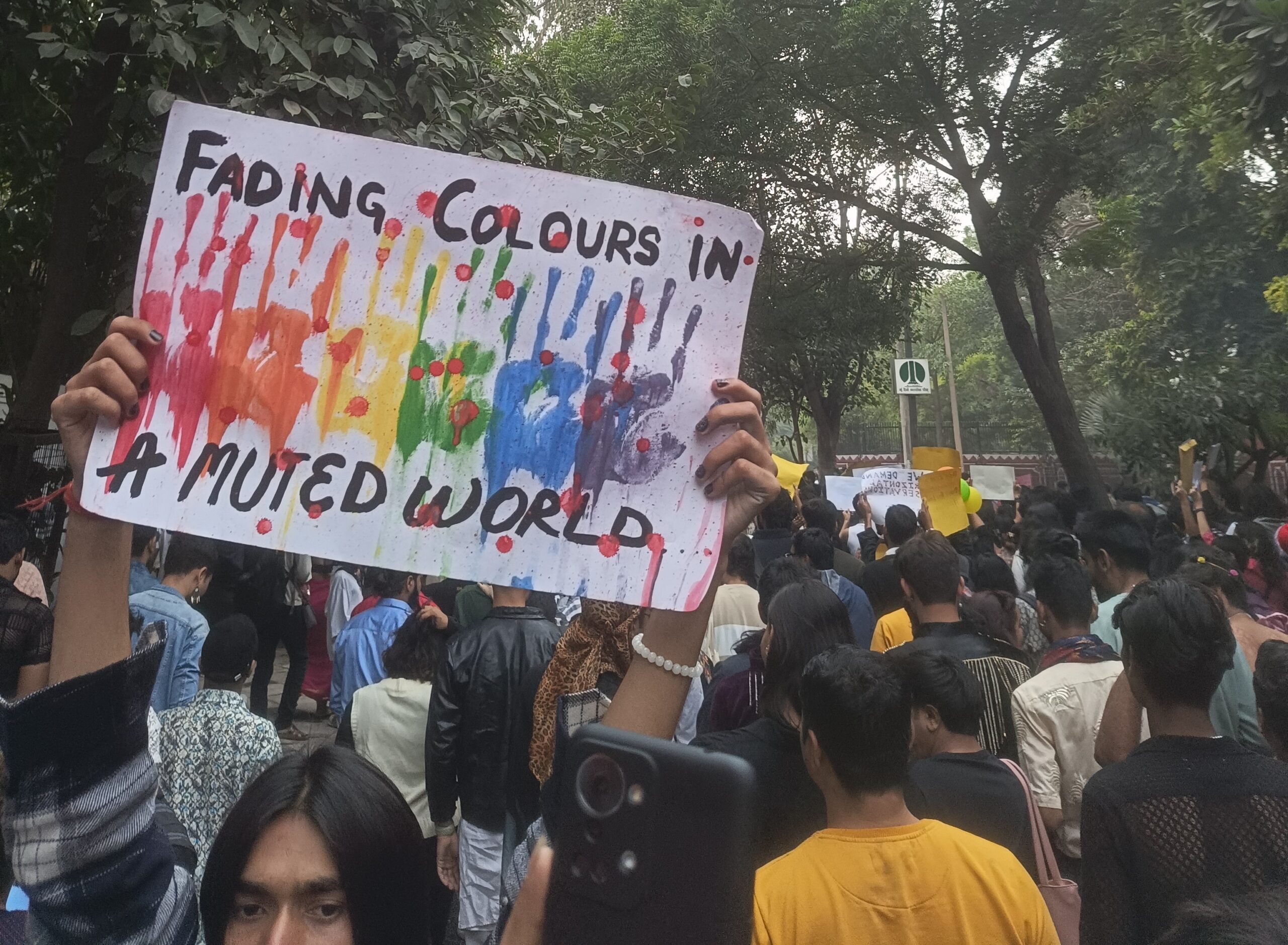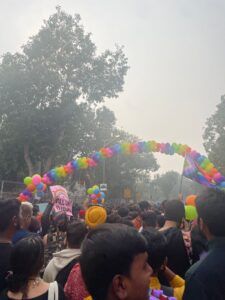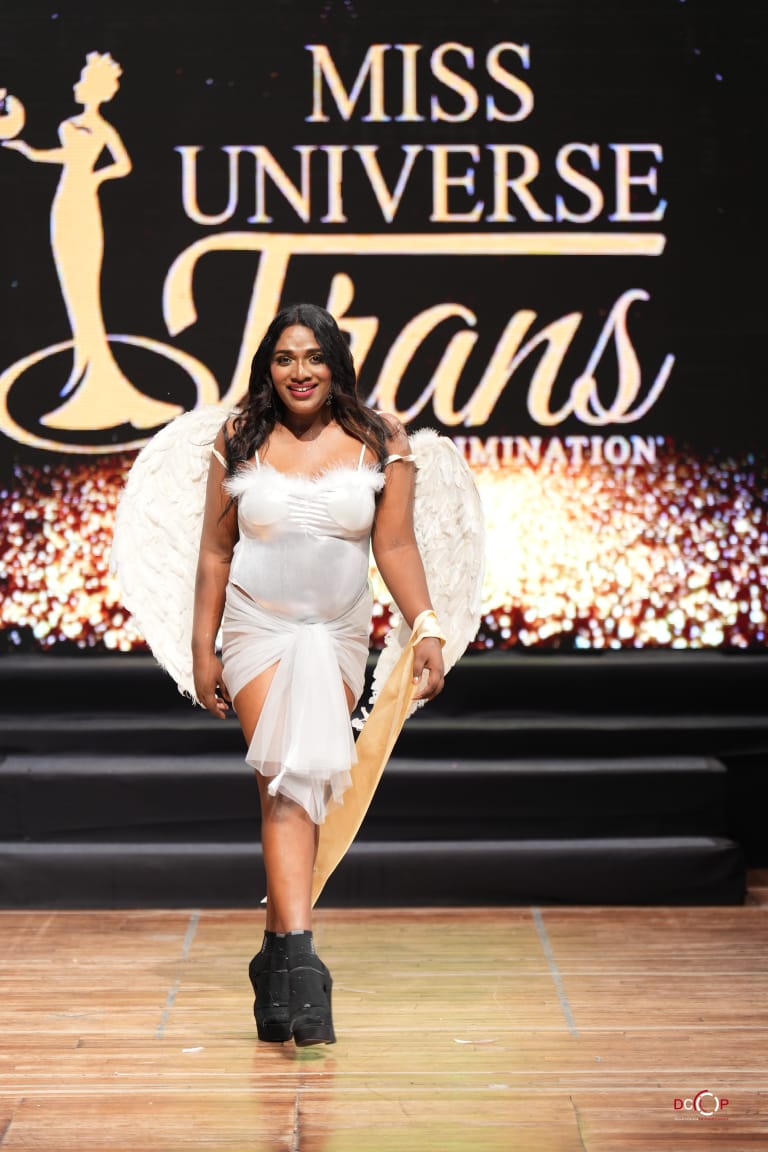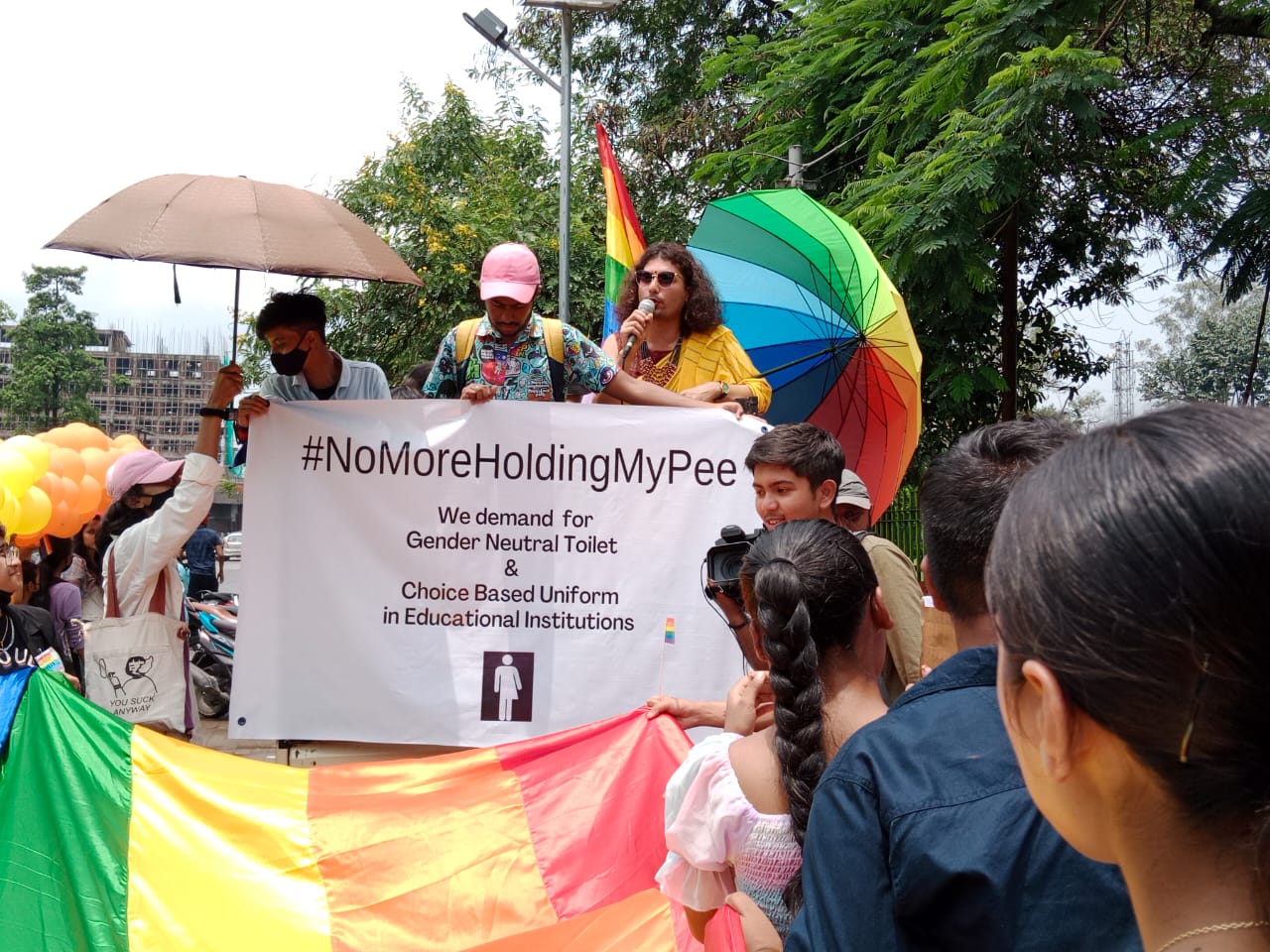
The queer community comes forward together at the Delhi Queer Pride 2023, whose ‘parcha’ mentioned: “We march against discrimination in educational institutions that leads to death by suicide”. Photo: Sahil Pradhan
Pranshu, a 16-year-old from Ujjain, was much celebrated on social media for his vibrant makeup artistry and the way he embraced his identity as a young queer artist. But on November 21, 2023, he died by suicide after his viral Diwali reel, in which he wore a saree, drew thousands of hate comments.
His mother, Preethi Yadav’s, raw grief struck a profound chord nationwide. Her voice has resonated with India’s LGBTQIA+ community, which is still reeling from the death of 16-year-old Aarvey Malhotra, who also died by suicide in February 2022, after facing severe harassment in school over his identity. For the queer community, these teens’ tragic deaths underscore the alarming mental health crisis and daily trauma of existing as vulnerable minorities stripped of institutional security. There is an urgent need to critically examine all complicit systems – from family to schools and social media.
#JusticeForPranshu trended on social media, but it was reported that the tag itself was removed for “violating community guidelines”. “But direct hate speech that kills people doesn’t violate anything?” asked many, furious at the unchecked hate that queer content creators face every day. Their fury underscored the life-threatening dangers of unchecked social media vitriol.
Facing family disapproval alongside intense online harassment and discrimination in educational institutions leaves minority youth profoundly vulnerable.
For 17-year-old Amit*, a queer college student from Delhi, the deaths of Pranshu and Aarvey reinforce a normalised truncation of aspirations – that questioning identity inherently jeopardizes safety. “I wish I could be as brave as them…my parents say it’s a phase. After getting trolled on my private accounts, I deleted everything. Living openly doesn’t feel worth it,” he admitted.
Divya*, a 15-year-old student, who belongs to the transgender community, echoes this loneliness. “Role models (like Pranshu and Aarvey) inspired me to find my voice. But after the backlash, I locked my page… I just feel so trapped in this small town in Assam; like no one would even notice if I disappeared,” they say.
Their shared despair reveals the heavier plight of countless queer Indian youths conditioned to silence, internalising hostility from family, friends and society. Faced with a lack of legal protections, youth support structures and affirmative spaces, they are stripped of security simply for embracing sacred explorations of the self.
For students, the failure of educational institutions to provide safe spaces is critical. Queer-affirmative psychologists are absent even at the most prestigious educational organizations, and provisions for action and measures to ensure safety for those bullied do not exist in their rules or guidelines.
A 2018 study jointly done by UNESCO and Sahodaran, a community-based organisation in Chennai, among sexual and gender minority groups, found that 60% of those identifying outside mainstream sexual identities were physically harassed in middle or high school, and 50% faced harassment in higher secondary school. Sexual harassment among the participants from primary schools stood at 43%. However, only 18% of them reported the bullying to school authorities. Even when they reported it, 29% of teens were asked to change their “perceived feminine behaviour” to avoid being bullied, and 49% were asked to ignore the incidents.
“In class 12, I stood for the post of president, and made it clear that I was trans and queer. The teachers told my parents that it was concerning that I believed I was trans, and that I was lying. It was horrible, and it couldn’t have been worse”, says Aiden, a student from Bengaluru.
Institutions are reluctant to change their curriculum, update dress codes or create gender-neutral training manuals, which often leads to queerphobia on campuses. Teachers reportedly mock, punish and reprimand kids who are uncomfortable wearing their assigned uniforms due to gender dysphoria.
Pallack Bhutani, a Delhi-based psychologist who has worked with various educational institutions, says, “The pernicious harassment that queer youth often endure in educational environments and social settings can engender psychiatric distress and internal turmoil. When adolescent students are persecuted due to their gender identity or sexual orientation, it frequently exacerbates underlying mental health conditions like depression and anxiety. ”
She says that these constant external pressures and microaggressions may catalyse suicidal ideations, emotional withdrawal, and leave lasting trauma in LGBTQIA+ teens already navigating complex developmental changes.
‘’Working closely with numerous queer young adults, I have witnessed the grievous psychological wounds inflicted by homophobic and transphobic bullying,’’ says Pallack.
Arshiya Kochar, programme manager at One Future Collective, a resource centre for queer people across India, says, “Depression, anxiety and suicide are disturbingly high amongst LGBTQIA+ youth and school-going children. Teachers play a huge role in building a strong support system.”
In 2019, a collective of women’s groups, queer groups, NGOs, students and academics working in the field of gender, sexuality and education drafted several recommendations for the Centre to incorporate in the Draft National Education Policy (DNEP). One of the key changes it suggested was this: “The DNEP’s section on transgender children (DNEP 2019 Chapter 6, Equitable and Inclusive Education, section 6.7, pp 153) is a welcome step, but should be phrased in broader terms to refer to all children who may not identify with, or express themselves in accordance with the gender assigned at birth. ’’
The delay in implementing gender-sensitive policies has ensured that the syllabus, teaching methods and school environment still remain queerphobic and unsafe for queer students. Bullies get away, they never understand or stop, and they can easily justify their doing.

Queer teenagers, especially those from small towns in India, find it very hard to be themselves in a society that shuns them. Photo : Sahil Pradhan
“If educators are homophobic, they enable bullying. So we have reached out to schools and educators to have a dialogue in order to sensitise them towards the needs of queer children. But most principals do not favour us conducting such workshops in schools,” says Meghna Mehra of the All-India Queer Association, who feels that teachers need to be sensitised during their training for the B Ed course.
Nilakshi Roy, a retired college professor and parent of a queer individual, says her child was bullied in school. “My child would come home crying, not wanting to go to school the next day,” she says.
Roy, whose child is now an adult, has started an online petition in 2021 urging the National Council for Educational Research and Training (NCERT) to reinstate its teaching manual for transgender children and those with non-binary identities.
The queer community feels that the education system can be made queer-inclusive only with the collective efforts of all stakeholders, including school authorities, teachers, curriculum makers and students.
In November 2021, the NCERT drafted a new module, ‘Integrating Transgender Concerns in Schooling Processes’, addressing transgender concerns, and suggesting teaching methods to develop an inclusive environment in educational institutions. However, the institution removed it from its website within 48 hours of publishing it, following complaints from the National Commission for Protection of Child Rights, which felt that “this approach will expose children to unnecessary psychological trauma.” This was a blow in the face of essential policy changes that are needed to safeguard queer identifying students in schools and beyond.
Along with the introduction of queer-friendly policies, educational institutions should also ensure that the legal rights of these students are protected. But a majority of schools are reluctant to conduct orientation sessions with queer rights organisations because of certain clauses in the Protection of Children from Sexual Offences (POCSO) Act. A case can be filed against an adult on the complaint of parents if they help a child with materials containing explicit content. This means that even when students reach out to queer rights organisations, either for support or help, they will not get access to important resources.
In June 2021, the Madras High Court officially suggested measures for changes in the school syllabus for LGBTQIA+ education of students, which included: “At schools, parents-teachers meetings should include sensitising and educating parents and gender non-conforming students to on the issues of the LGBTQIA+ community, to ensure families are supportive of their children.”
It further stated: “Policies and resources should support students belonging to the LGBTQIA+ community in all spheres of their academic life. For this, educational spaces should include gender-neutral restrooms, change the name of the genders on academic records for individuals and include the term ‘transgender’, creating an LGBTQIA+ inclusive environment for the staff and students.” The judgement was rendered on June 6, 2021, by Justice N Anand Venkatesh based on a plea filed in the Madras High Court by a lesbian couple seeking protection from their relatives.
Dr Sangeeta Saksena, the co-founder of Enfold Proactive Health Trust in Bengaluru, explains that these steps towards education and awareness can start small.
Enfold, which holds gender and sexuality education sessions with schools, parents, and other stakeholders, “has made its language non-binary from class 1 onwards,” Dr Sangeeta says. “In class 5, we introduce ‘intersex’ and ‘transgender’ into their vocabulary. When doing gender equity and sensitisation, we ask if people of certain genders can only do certain jobs. Do you think a trans person can do this job? Why not? From class 5 onwards, we start talking in general to every child like this,” says Dr Saxena.
Purple Board, initiated by the Society for People’s Awareness Care and Empowerment in association with the Directorate of Education, Delhi Government, and the Netherlands Embassy, has certified 27 Delhi schools, (of which 25 are government-run schools), as “trans-friendly” or transgender-inclusive”. This project aims to make education accessible for transgender and gender non-conforming children by addressing transphobia and identifying and eliminating trans-bullying. Interestingly, the majority of principals present at the award ceremony admitted they did not know what the word “transgender” meant before the workshop.
The students at Tagore International School in Delhi run a campaign called “Breaking Barriers” to raise awareness about sexuality and gender identities, and have started programmes to support children and train teachers.
Educators, teachers and staff members can do much to help queer students. For instance, by learning to empathise, teaching children of all gender identities while acknowledging their presence, avoiding queerphobic terminologies, being there for the students, and helping them be safe not just in classrooms, but also on the campus and in their homes.
The queer community wants the education system to include queer people inside their learning sphere, both in real life and in textbooks. Having people from queer rights organisations or people from the community itself, or even students who identify as queer, will definitely give hope to other children that they wouldn’t be discriminated against just for being different.
Making the education system more queer-friendly is not something that can be done by a single individual. There needs to be a team of supportive educators to advocate the issues of LGBTQIA+ students to school administrations and directly implement LGBTQIA+ content in the class curriculum. They must address anti-LGBTQIA+ bullying or harassment, and serve as advisors for students to organise supportive groups at school formally.
For students, having adult allies in school to whom they can turn for support — or even simply knowing that LGBTQIA+ friends exist on the campus — creates a more welcoming and safer environment to learn and grow.
(*Some names have been changed to protect privacy.)



